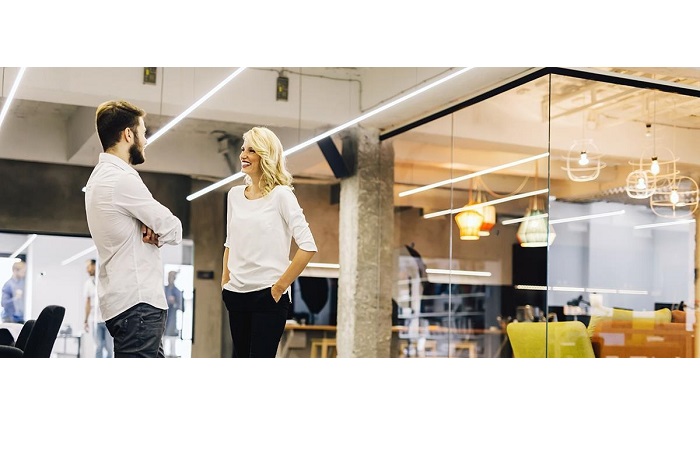
In recent years there’s been a growing emphasis on supporting mental health and wellbeing in the workplace – and for good reason. With statistics indicating that one in six employees suffer from some form of mental health issue in the UK, prioritising staff wellbeing is becoming an essential part of working culture.1
Of course, there are various ways to positively promote mental health in working environments such as improved benefit programmes, management support structures and flexible working hours, but in this article, we’ll be focusing on the physical aspects of workplace design that can contribute to improved wellbeing.
1. Clever colour schemes
The power of colour psychology and the effect it can have on a person’s mood is no secret and has been effectively utilised in sectors like advertising and marketing for years. With this in mind, these same principles can and should be considered when it comes to designing working environments that are looking to positively influence staff morale and overall wellbeing.
When assessing the benefits of colour for your workplace design, it’s essential to evaluate the different tasks and individual needs. After all, there are some areas of your business that may benefit from more muted hues, while others could accommodate brighter and bolder shades.
One colour primed for promoting a sense of calm and serenity is green. With a close association with nature, green hues can deliver a mood-enhancing element to working environments – perfect for high-pressure situations. Whether you decorate office walls with a soft sage or you embellish areas with indoor plants, even a small addition of green could have positive connotations with employees.
Naturally, there will be times where you need to stimulate creativity and productivity, so consider colours that can spur this thought process like yellow and orange. Generally thought to promote happiness and enthusiasm, these attention-grabbing colours can be effectively used in creative environments. However, be mindful that these colours aren’t overwhelming – think splashes of yellow and orange like a company logo, a decorative mosaic tile feature or a motivational quote.2
2. Let the light in
In addition to colour, the presence or lack of natural light can have a serious impact on a person’s mood and general health. One study showed that workers with increased exposure to natural light in the workplace experienced fewer physical effects, including eyestrain and headaches.3
Taking a pared-back approach to workplace interiors could be the key to allowing as much natural light to flood in as possible. Think about removing bulky furniture and heavy window dressings that could be blocking out the light. To ensure this doesn’t hinder temperature regulation or increase sun glare, you could invest in blinds that filter the light through while absorbing the heat from the sun.
You could also look to other ways to bring natural light in from above through skylights. For instance, in working environments like warehouses and factories where windows are few and far between, the addition of overhead windows could ensure employees don’t feel enclosed and deprived of natural light. In instances where natural light isn’t in abundance, there are also options to upgrade artificial lighting to illuminate the area effectively.
3. Prime your layout for movement
In the modern workplace, many employees remain sedentary for long periods of time sitting at their desks, which not only increases their risk of developing chronic diseases such as diabetes and heart disease, but it can also reduce their productivity and general morale.4
To combat this current trend, many employers are looking to incorporate different ways to allow employees to be active during working hours – even if it’s for just a short period of time.
One such method is to develop a layout that promotes social interaction amongst staff and encourages movement between departments, naturally integrating a more active culture. In addition, populating communal areas with standing desks or break out areas with comfy seating that still allows them to work will give workers more chances to move around in the office.
You can even take this one step further by ensuring your workplace offers changing and showering facilities, so staff can freshen up after a walk, run or cycle either to work or on their lunch break.
4. Improve the air quality
Whether you realise it or not, the quality of air in your workplace could be having a significant effect on staff health, with research showing that more fresh air in the workplace can increase productivity and reduce the number of pollutants in the air, too.5
While many modern office buildings have sealed windows and large-scale heating and cooling systems built in, simply opening the windows to let fresh air in isn’t an option. However, the introduction of indoor plants could be your answer. Not least, their green hues will have a calming and de-stressing effect, but plants naturally purify the air by absorbing CO2 and releasing oxygen during photosynthesis – making them a valuable addition for promoting a working environment that prioritises health and wellbeing.
The importance of wellbeing and mental health concerns in the workplace is continuing to be a priority for businesses across all sectors. And when it comes to workplace design, we hope you’ll find these insights helpful in actioning a well-thought out space that’s primed for supporting every employee.
This article first appeared on jelf.com.
Sources:
1 Mind 2019
2 verywellmind.com 2019
3 prnewswire.com 2018
4 theconversation.com 2018
5 Forbes.com 2019
Marketing communication FP19.597